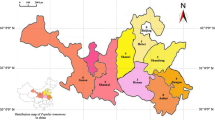Abstract
Red clover (Trifolium pratense L.) is an important perennial forage crop in Europe. Unfortunately, seed production of modern cultivars is often unsatisfactory and breeding progress for higher seed yield is slow. We evaluated whether marker assisted parentage analysis could identify progeny plants with two high seed-yielding parents in a diploid selection trial. Furthermore, we studied if breeding for high seed yield could be speeded up by selecting progeny plants with two high seed-yielding parents, compared to traditional selection on the mother plant only. In this study, 111 genotypes with excellent vegetative traits from a first cycle selection trial were allowed to pollinate each other in isolation. After seed harvest, ten high seed-yielding plants were identified and their seeds were used to grow ten half-sib progeny populations, with 1,121 plants in total. Two multiplex primer sets targeting 18 SSR loci were designed and used to fingerprint parental and progeny plants. Parentage was reliably determined for 1,083 progeny plants: 135 plants were the result of a cross between two high seed-yielding parents. In a 2-year seed yield trial, the seed yield of these 135 progeny plants was compared to that of a control group of 216 progeny plants from the same ten high seed-yielding mother plants but with no selection on the male contribution, as is current practice. Compared to the control group, progeny plants with two high seed-yielding parents had significantly higher seed yields, 23.0 and 75.9 % higher in 2012 and 2013 respectively, and a significantly higher thousand seed weight, 6.6 and 5.7 % higher in 2012 and 2013 respectively. Seed yield was strongly correlated with flower abundance (r = 0.643) and plant volume (r = 0.593 in 2012 and r = 0.509 in 2013) and negatively correlated with susceptibility to mildew (r = −0.145). We conclude that breeding programs aiming at increasing seed yield in diploid red clover cultivars would strongly benefit from the integration of marker assisted parentage analysis to identify those progeny plants that are the result of a cross between two high seed-yielding plants. This goal cannot be achieved with traditional family selection where only the seed yield of the mother plant is known.





Similar content being viewed by others
References
Belzile L (1991) The effect of soil type on red clover seed yield. Can J Plant Sci 71:1039–1046
Boller B, Schubiger FX, Kölliker R (2010) Red clover. In: Boller B (ed) Handbook of plant breeding. Springer, Dordrecht, pp 439–455
Brodsgaard CJ, Hansen H (2002) Pollination of red clover in Denmark. DIAS Rep 71:1–50
Deneufbourg F (2004) Seed yield of forage crop cultivars. Bull Semen 175:20–21
Gerber S, Chabrier P, Kremer A (2003) FAMOZ: a software for parentage analysis using dominant, codominant and uniparentally inherited markers. Mol Ecol Notes 3:479–481
Herrmann D, Boller B, Studer B, Widmer F, Kölliker R (2006) QTL analysis of seed yield components in red clover (Trifolium pratense L.). Theor Appl Genet 112:536–545
Isobe S, Kölliker R, Hisano H, Sasamoto S, Wada T, Klimenko I, Okumura K, Tabata S (2009) Construction of a consensus linkage map for red clover (Trifolium pratense L.). BMC Plant Biol 9:1–11
Kalinowski ST, Taper ML, Marshall TC (2007) Revising how the computer program CERVUS accommodates genotyping error increases success in paternity assignment. Mol Ecol 16:1099–1106
Macherey Nagel (2008) Genomic DNA from plant user manual NucleoSpin Plant II. vs. 08.02, pp 1–32
Malengier M, Baert J (2007) Heritability of seed yielding capacity in tetraploid red clover (Trifolium pratense L.).In: Abstract Book of the 27th EUCARPIA symposium, p 68
Oliva RN, Steiner JJ, Young WC (1994) Red clover seed production: 2. Plant water status on yield and yield components. Crop Sci 34:184–192
Riday H (2011) Paternity testing: a non-linkage based marker-assisted selection scheme for outbred forage species. Crop Sci 51:631–641
Riday H, Krohn AL (2010) Increasing population hybridity by restricting self-incompatibility alleles in red clover populations. Crop Sci 50:853–860
Rincker CM, Rampton HH (1985) Seed production. In: Taylor NL (ed) Clover science and technology. American Society of Agronomy, Madison, pp 417–443
Sato S (2005) Comprehensive structural analysis of the genome of red clover (Trifolium pratense L.). DNA Res 12:301–364
Signorovitch J, Nielsen R (2002) PATRI-paternity inference using genetic data. Bioinformatics 18:341–342
Silberstein TB (1994) The effects of paclobutrazol and uniconazol on red clover seed production. Dissertation, Oregon State University
Smolikova M, Kailerova J, Nedbolkova B (1987) Correlation between fodder and seed traits in genotypes of red clover. Sborník vedeckých prací Výzkumného a slechtitelského ústavu pícninárského v Troubsku u Brna 10:83–92
Steiner JJ, Smith RR, Alderman SC (1997) Red clover seed production: IV. Root rot resistance under forage and seed production systems. Crop Sci 37:1278–1282
Taylor NL (2008) A century of red clover breeding developments in the United States. Crop Sci 48:1–13
Taylor NL, Quesenberry KH (1996) Red clover science. Kluwer, Dordrecht
Van Eenennaam AL, Weaber RL, Drake DJ, Penedo MCT, Quaas RL, Garrick DJ, Pollak EJ (2007) DNA-based paternity analysis and genetic evaluation in a large, commercial cattle ranch setting. J Anim Sci 85:3159–3169
Vasiljevic S, Surlan-Momirovic G, Katic S, Mihailovic V, Lukic D, Zivanovic T (2000) Relationship between green forage and seed yield components in genotypes of red clover (Trifolium pratense L.). Genetika 32:37–43
Acknowledgments
The authors would like to thank Joke Dumortier, who did a part of the laboratory work in the framework of her bachelor thesis. We also thank Nancy Mergan and Geert Lejeune and the technicians supporting red clover breeding activities at ILVO for their technical assistance.
Author information
Authors and Affiliations
Corresponding author
Rights and permissions
About this article
Cite this article
Vleugels, T., Cnops, G. & Roldán-Ruiz, I. Improving seed yield in red clover through marker assisted parentage analysis. Euphytica 200, 305–320 (2014). https://doi.org/10.1007/s10681-014-1188-z
Received:
Accepted:
Published:
Issue Date:
DOI: https://doi.org/10.1007/s10681-014-1188-z




